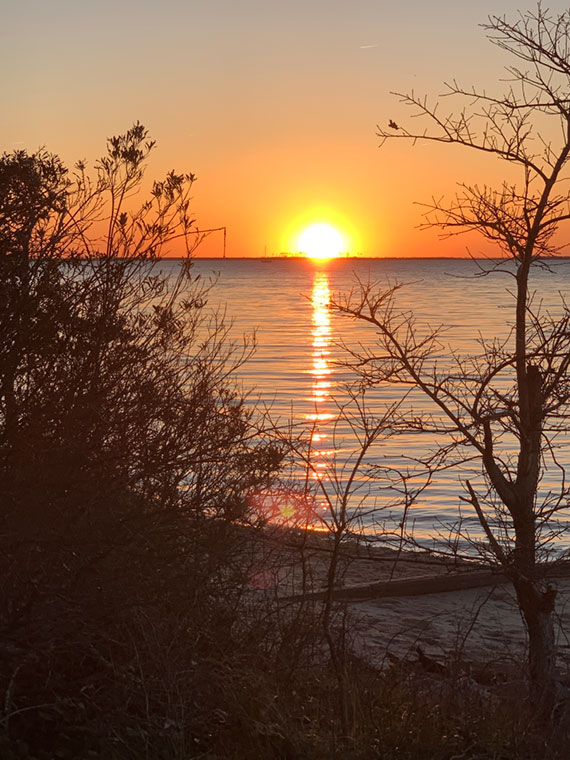
A lighthouse. A national park. A beach in winter. We hit the trifecta!
Three things we love, knit together into an opportunity at Bodie Island Light Station on Cape Hatteras National Seashore, the 70-mile string of barrier islands just off North Carolina. The VIP (Volunteers in Parks) program from the National Park Service offered the winning ticket.
Spoiler alert: We didn’t climb the lighthouse’s 219 steps to turn on the beam that guides sailors along the Outer Banks. As it happens, the vintage lens has been automated since the 1930s.
But as full-time National Park Service volunteers, we did yeoman’s work running the visitor center, housed in the former keepers’ quarters directly in front of the black-and-white striped icon.
More than 700 lighthouses currently stand in the United States. Here's a captain's log of our days at one of the finest.
Sunday, Jan. 8
First week
After being issued National Park Service shirts, hats, sweaters and nametags, we don our gear with anticipation. Ranger Tom, our immediate supervisor, is at a training workshop all week, so his boss, Ranger Jonathan, shows us the ropes, including a refresher on raising the American flag.

During the week, we newbies make bold moves, shifting displays and information. When Ranger Tom returns, he's remarkably OK with what could have been regarded as chutzpah overload.
Whether it's Tom, Jonathan or other seashore employees, they impress us with their selfless dedication. Plus, they're soooo nice.
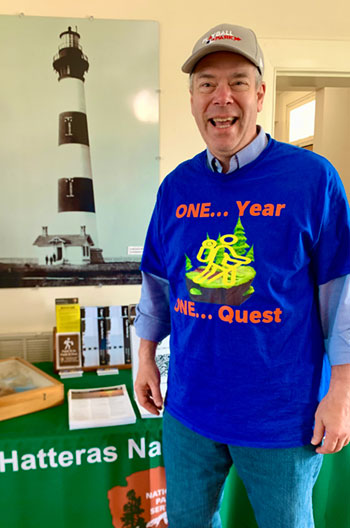
Meeting interesting adults and kids from all over the country...the world...is an unexpected bonus. A college troupe performs a Bollywood-style dance in front of the lighthouse. A retired man from Ohio is attempting a world record: Visiting all 424 national park entities in one year. (His mission got harder when the tally increased from 423 to 424 - and he had already printed the T-shirts.)
A California woman in her 20s, who motored cross-country with her dog, plans to sleep in her minivan at Oregon Inlet Campground. Gregarious senior citizens from Cleveland, where the temperature is in the 30s while it's nearing 60 here, have driven 10 hours for their getaway.
Thursday, Jan. 12
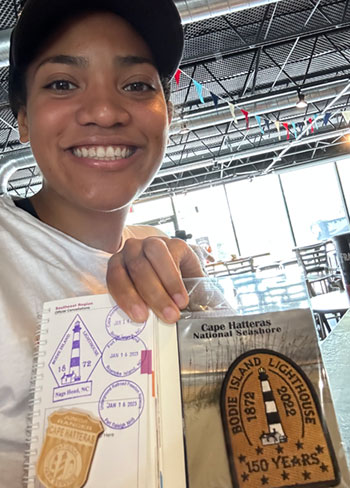
A Coast Guard officer who's based on an icebreaker in the Antarctic shows us videos of an orca whale swimming alongside her ship and penguins hopping on the tundra. At 27, Leah still collects Junior Ranger badges from National Parks.
She cheerfully finishes five fun activities in the Junior Ranger booklet, raises her right hand to take the pledge to protect the park, and accepts the badge from us.
The Junior Ranger program is one of the most delightful aspects of this job. The booklets are aimed at ages 5 to 13, but individuals of any age and ability can participate.
We enjoy paying extra attention to kids with special needs.
Bestowing the badge on new Junior Rangers with great ceremony, we do everything short of saluting and singing "The Star-Spangled Banner." Our augmented proclamation is intoned thusly: "By the power vested in us by the National Park Service of the United States of America, we hereby declare you a Cape Hatteras National Seashore Junior Ranger!"
Sunday, Jan. 15
Martin Luther King Jr. weekend

Their necks slung with binoculars and cameras, bird-fanciers from the Carolinas convene at Cape Hatteras National Seashore, which provides nesting, resting and wintering habitat for birds.
Feathered creatures migrating along the Atlantic Flyway gather at the pond behind Bodie Island Light Station. Birders are agog at the tremendous number and variety, including tundra swans and greater snow geese. Bald eagles are sighted as well. On the observation deck, ornithologists lecture about the waterfowl.
Saturday, Jan. 21

After two weeks, we feel like island royalty. We've immersed ourselves in lighthouses past and present, pouring through binders prepared for volunteers as well as library books.
Gaining an understanding of these watchtowers teaches us about science, history, politics, government, technology, economics...Are we nerds? OK, we're nerds.
Ask anything and we can riff aquatic. That's good because the subject matter for visitor questions is as wide and deep as the sea: The date the lighthouse will be open for climbs to the top. The ferry to Ocracoke. Ducks. Rattlesnakes. Deer. Nutria (critters in the rodent family that are kinda cute), which have taken up residence under the boardwalk that leads to the pond.

Plus: Only one lightbulb illuminates the lighthouse; it's the ingenious series of prisms in the Fresnel lens that creates the intense shine. The gleam can be seen 17 nautical miles out to sea. The notorious pirate Blackbeard was killed when he ran aground on a nearby sandbar. During World War II, German U-boats lay in wait to blow up passing freighters and tankers.
And: Passes to take four-wheel drive vehicles onto the beach. Sea glass and shark's teeth are rare but eggs from fish called skate - similar to rays - are abundant. The ebb and flow of Outer Banks sands. The first known lighthouse was in Egypt. The correct pronunciation of the station's name - officially "Body." Campgrounds. Shipwrecks. Beachcombing.

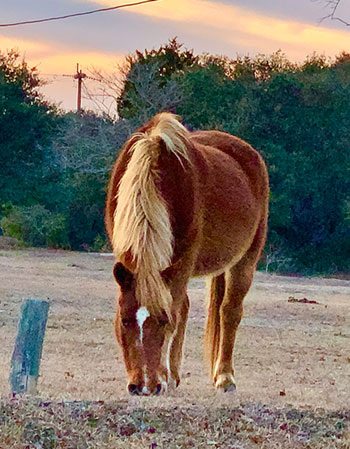
More: Other regional highlights, including wildlife refuges, parks, marinas and the N.C. Aquarium in Manteo, which houses a sea-turtle rescue. (There, we're enamored by a 209-pound loggerhead known as Miss Piggy, a crowd-pleaser who has since been outfitted with an online satellite tracker.)
Thursday, Jan. 26
We have boatloads of information to share. The question is: How much do casual drop-ins want to discover?
A few tourists don't even get out of the car, shooting a photo through an open window. Some sprint around the center before hurrying to the next attraction. At the other end of the spectrum are those who peer at each picture, artifact and sign, sometimes inquiring about even minor details.
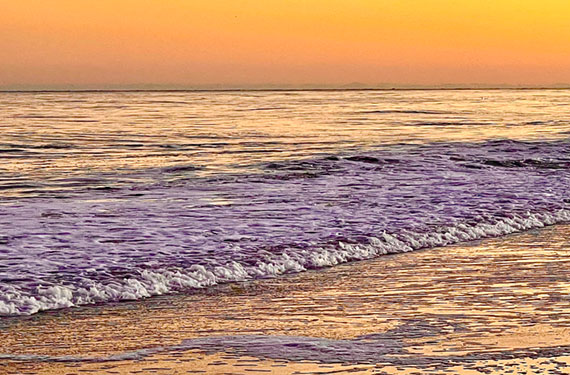

The lighthouse keepers' lives is a hot topic. When few people lived on Bodie Island and going anywhere required taking to water, these noble men and their families worked tirelessly to maintain the light - fueled first by pig lard and then by kerosene. Their backbreaking labor included regularly climbing to the top of the tower hefting a 50- to 70-pound oil can.
The lighthouse keeper and his assistant had to be self-sufficient in the then-isolated location. Except for occasional boxes of dry goods from the federal government, they procured food by fishing and hunting. Although they attempted to grow crops and raise animals, the sandy soil made it nearly impossible. The keeper's salary in 1872: $400 a year.
Challenges persisted into the 20th century. In the 1930s, a keeper tied a rope around his 18-year-old son's waist and dangled him from the tall windows of the lighthouse so he could paint it.
Even in 2023, there's a tale that the fireplace in the former keepers' duplex, now the visitor center, is haunted by a ghost who makes the scene every day at 4. We never saw it; the apparition must have been on winter break.
Sunday, Feb. 5

The variety of guests means helming the visitor's center never gets old.
Two recent college graduates who're employed by the NOAA (home of the National Weather Service) stroll in. Mike from Boston, who lives on a boat, will be based in Alaska. Brennan from Colorado will be based in Mississippi, where he'll ship out to places that suffer natural disasters.
We take it as a compliment when the husband of a deaf woman ceases signing to translate our words because we're making sure to face her and enunciate.
However, it's not all smooth sailing. A skinny, heavily tattooed guy in his 20s, wearing a grimy T-shirt and dark sunglasses, shuffles to the desk with a woman we surmise is his girlfriend.
She's curious, coming up with lots of good questions, but he seems out of it, so we focus on her. Until we spot something shiny on his hip. A gun. In a holster.
We're scared. North Carolina generally allows people to openly carry firearms in public, but not inside federal buildings like the visitor center. There are small ghost-buster "No Guns Allowed" stickers on the windows.
If you're intent on walking around like Billy the Kid, maybe you missed them? Perhaps you don't realize this is a federal building? Or could it be something worse?
Unsure of what to do, we do nothing, trying to steady our nerves while continuing to provide answers. After the gunslinger and his gal leave the building, a National Park Service law enforcement officer explains by phone that he's too far away to get to the scene in a meaningful amount of time. And anyway, firearms are allowed outside.
Friday, Feb. 10

We're learning boatloads by reading the prize-winning "Brilliant Beacons - A History of the American Lighthouse" by Eric Jay Dolin.
Under the jurisdiction of the Treasury Department from 1789 to 1903, it explains, the U.S. Lighthouse Service offered safe passage for countless people, saving innumerable lives as well as dollars, thus contributing to the prosperity of the nation.
"As the country grew, so did the number of lighthouses," Dolin writes, "creating a necklace of beacons and literally lighting the way for the settlement of new territories and states."
A woman from Michigan, which boasts the most lighthouses in the country, says she's passionate about them, so we show her "Brilliant Beacons." Like other lighthouse fans, she shoots a photo of the cover so she can order it. We should get a commission.
Sunday, Feb. 12
Super Bowl Sunday
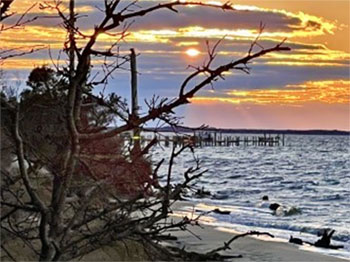
The weather is nasty: cold with heavy downpours and flooding expected. Over eight hours, only 36 people swing by.
There's an intriguing cost-benefit argument about seeing places off-season or in bad weather. Conditions aren't optimum, but you'll probably have the spot to yourself.
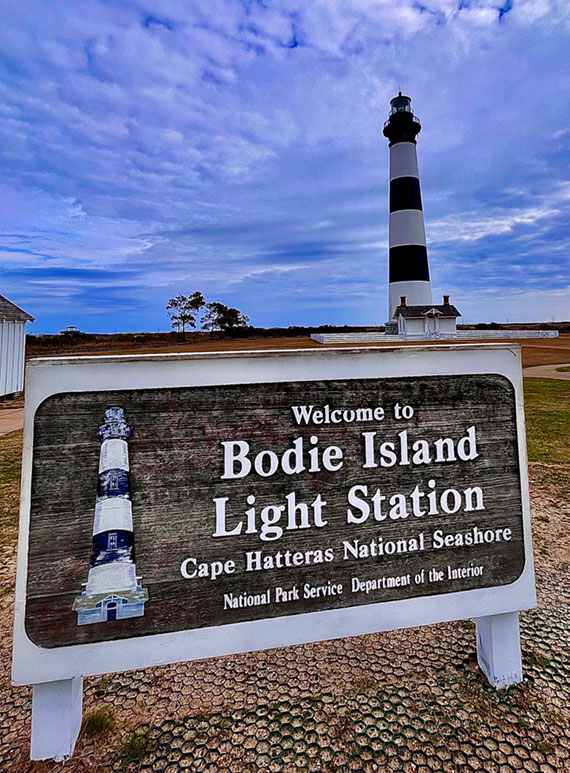
Thursday, Feb. 16
It often feels as if we're hosting Meetups.
Two Gen Z guys - rocking a grungy, outdoorsy vibe - who live near Yosemite hear that a couple in their 80s is from California, too. The eclectic group starts exchanging tales about excellent trips taken in their home state.
We're standing with a retired husband and wife who worked in New York theater; he handled lighting for the Metropolitan Opera, she was a dancer and choreographer. We introduce them to a younger Big Apple duo. All four are fascinated by the lighthouse and pleased to meet fellow residents of the Northeast.
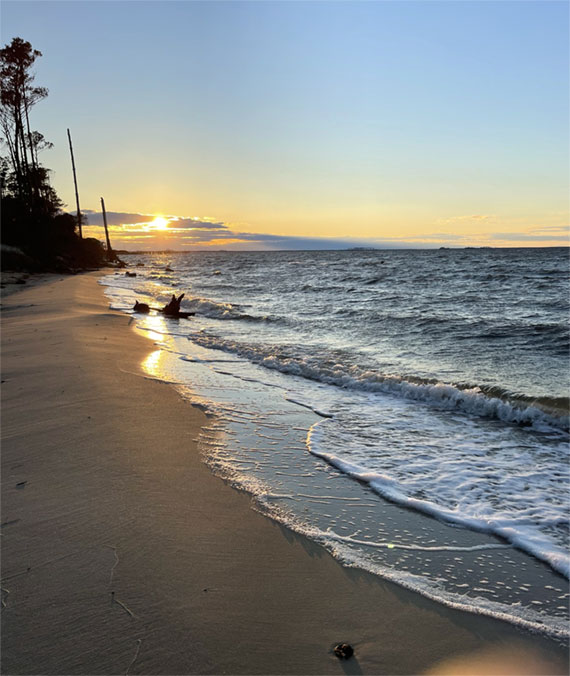
Saturday, Feb. 25

Many people assume Bodie's landmark is the one that was moved in 1999 due to ocean encroachment. But that's the tallest-in-the-country Cape Hatteras Light Station, with diagonal stripes, about an hour south, which was lit in 1870. The Ocracoke Light Station, built in 1823, is the oldest of the salty dogs.
For clarity, we pull a map from the middle of the park newspaper, mark it up in color, write in additional information, and leave it out for passersby to peruse.
A troop of 30 Boy Scouts from Bladen County steams through. The adult chaperones say they're on a tight schedule; we want the kids to get Junior Ranger badges.

In the interest of time, we say, the boys can work together to do the five activities in the booklet.
Shortly after, we make an executive decision. "Since most of you have finished, everybody's going to get a badge. If you haven't completed your activities, do them at home."
It's moving to hear 30 troopers repeating the park pledge in unison. Very seriously. They're Boy Scouts.
Sunday, Feb. 26
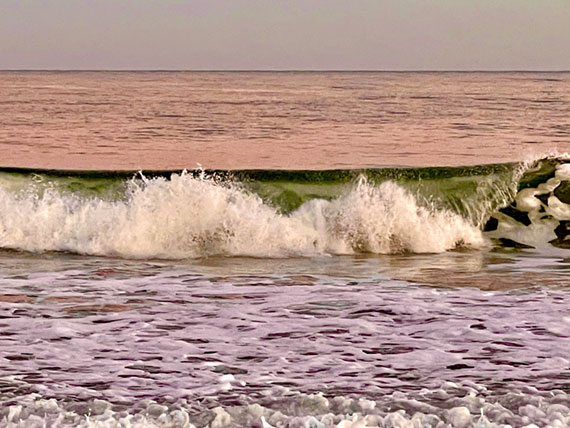
Some wanderers are on a quest that has taken them away from a 9-to-5 anchor.
We meet a couple in their early 30s who can work remotely so they're crisscrossing the country with their child in an RV.
Also living in an RV full-time is a family of four (mom, dad, teenagers). Their business card says that they're preachers on wheels. As the dad explains, they drop by a church here and there to see if its leader wants them to stick around. We wonder if the family's enjoying the unconventional lifestyle. Behind the father, a son rolls his eyes and shakes his head no.
Saturday, March 4
High spirits at the lighthouse are common. Two middle-aged women exaggerate slow ballerina moves toward each other. A multigenerational family plays Frisbee on the lawn. Everyone trades travel stories.
Nine antique Fords, including a 1923 Model T, pull up and park side by side at an angle so they're in the foreground of the lighthouse. The owners of the cars are friends from Charlotte who take these jaunts together, creating a sensational spectacle.
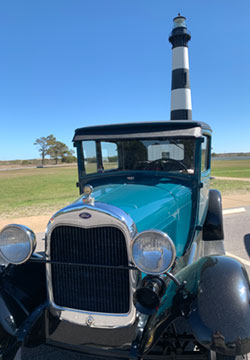
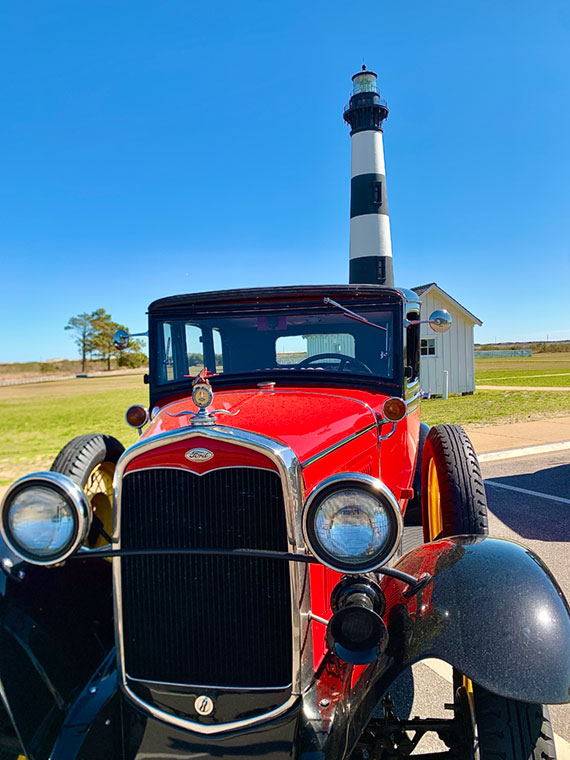

Sunday, March 5
A motorcycle gang roars into the parking lot with some 20 riders wearing leather jackets emblazoned, "The Enforcers." We're spooked by their tough appearance. But wait, does a gang member inquire about erosion?
Relief: They're members of a Crystal Coast group working in law enforcement. A woman in her late 30s remarks: "If you'd ever told me I'd be wearing leathers and riding a motorcycle..."

Thursday, March 9
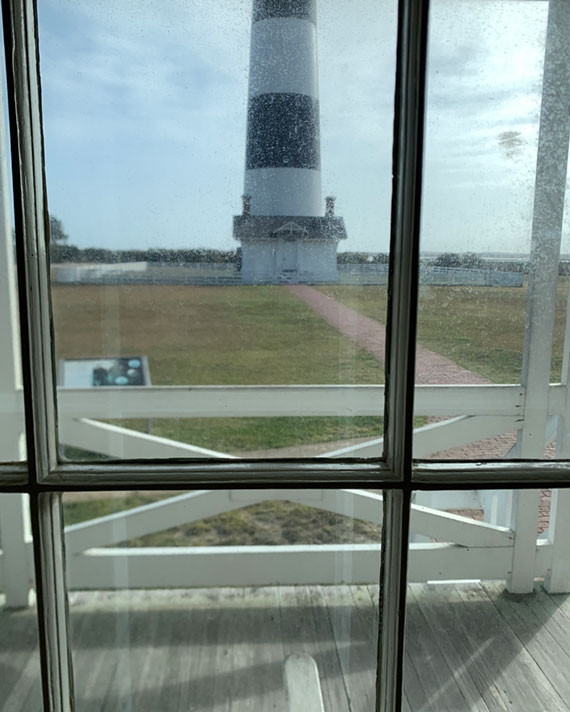
Through the windows of the visitor center, sunshine promises great weather, but pine trees are bending due to 30-mile-per-hour wind gusts. We must hold on to our ranger hats or they'll fly off as we walk the grounds to greet visitors.
Most-asked question: Where's the bathroom? Second-most: When will the lighthouse open for climbing? The sign promising "spring" is leading to even more queries now that it's March.
A group of 61 eighth-graders arrives, so Ranger Tom unlocks the base of the lighthouse itself. It's exciting to tell others about this out-of-season opportunity. And it's our first glimpse into the lighthouse since orientation day; so much more makes sense.
Friday, March 10
Dreary, rainy day. The few hearty souls include college students on spring break.
A family of four visiting from Johannesburg, South Africa, gets the award of the season for journeying the farthest. Or should that be the safari guide from Zimbabwe? Or the IT workers from Australia?
Visitors have come from many countries, including Canada, Honduras, Colombia, the Netherlands, Belgium, Germany, Italy, France, Spain, Japan, China and India.

Saturday, March 11
What a difference a day makes. Record number of daily patrons: 264.
Strangers share so much of their lives with us. Maybe it's something about our uniforms. Botanist...technical diver...astronomer...agriculture professor...so many compelling people.
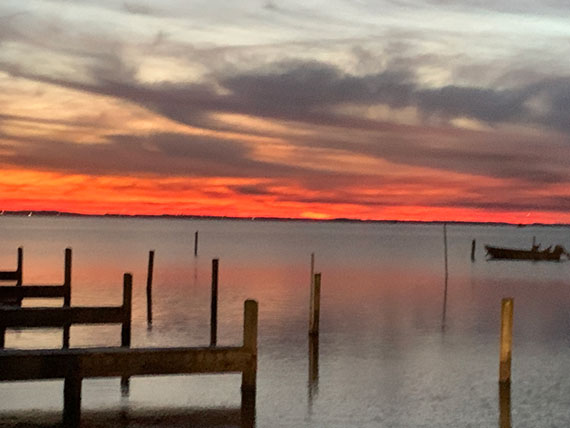
Six Coast Guard members doing additional training in Norfolk explain that their studies included using points on land, such as lighthouses, to get their bearings because advanced technology can fail. A seaman who's stationed in Miami shows us a photo of him, in uniform, dropping supplies to Cuban citizens who are desperately attempting to reach the United States.
Friday, March 24

The Bodie Island Light Station will open for climbing on April 26. After hearing that the 219 steps may be mounted soon, a husky fellow guffaws, "Is there a fast lane and a slow lane?"
A teacher from Michigan, who's traveling solo, chooses one state to explore every year. North Carolina is No. 32. Starting in Asheville, she has roamed from the mountains to the sea.
A couple drops by with their two kids and grandma. The dad says he popped the question on the beach near here. The proposal was written on an oyster shell. To keep the ring inside the oyster, he had drilled two holes to loop a wire and covered the inside surface with velvet.
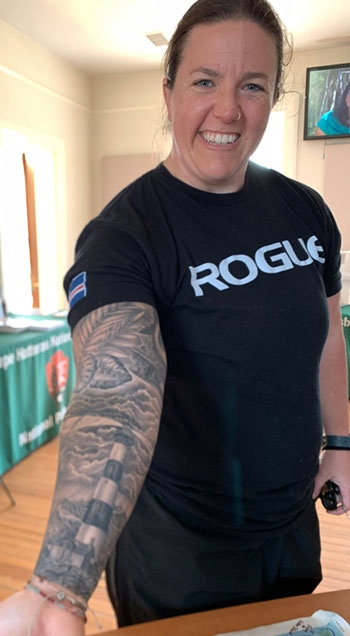
Fifteen minutes before closing, Leslie from Burlington enters with a stunning reproduction of the Bodie Light Station tattooed in large scale on her arm.
Saturday, March 25
A couple from North Dakota appear. They're the first from that state in the three months we've been here.
We often strike up a conversation with "Where ya from?" Sometimes that elicits complicated answers. Often it triggers a fascinating exchange.
Ohio? Our very good friend lived in Canton. New York? We're mad for Broadway. Durham? How 'bout those Bulls? If you've lived long enough and had enough experiences, you can relate to just about anyone.

Eric, who's been employed by the historic preservation arm of the National Park Service for decades, stops in. He's restoring plaques and other significant resources in nearby Fort Raleigh. Based in Maryland, Eric travels all over the nation.
His favorite posting was in Hawaii. In 2005, he worked at a colony for leprosy patients that was slated for transformation into a national park. He played cards with the 12 remaining patients, some missing fingers due to the ancient scourge.
Friday, March 31
Last day

In the first hour, there are sightseers from New Mexico, Minnesota, Ohio, Illinois and, of course, Raleigh and Durham.
Three months in, and the Bodie Island Light Station has become "our" lighthouse. We thrill to see its luminosity at night, in the early morning or when it's overcast.
We're excited to impart everything we've discovered to anyone who asks a question...even to bewildered individuals whose inquisitiveness extends only so far as the bathroom's location.
Out walking the grounds for the last time, we encounter a visitor who gushes, "The lighthouse is beautiful." With a pride that often springs from a sense of ownership, we instinctively respond, "Thank you."
